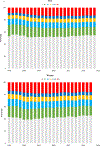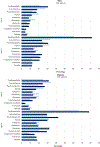Life Course Patterns of Prescription Drug Use in the United States
- PMID: 37728437
- PMCID: PMC10656114
- DOI: 10.1215/00703370-10965990
Life Course Patterns of Prescription Drug Use in the United States
Abstract
Prescription drug use has reached historic highs in the United States-a trend linked to increases in medicalization, institutional factors relating to the health care and pharmaceutical industries, and population aging and growing burdens of chronic disease. Despite the high and rising prevalence of use, no estimates exist of the total number of years Americans can expect to spend taking prescription drugs over their lifetimes. This study provides the first estimates of life course patterns of prescription drug use using data from the 1996-2019 Medical Expenditure Panel Surveys, the Human Mortality Database, and the National Center for Health Statistics. Newborns in 2019 could be expected to take prescription drugs for roughly half their lives: 47.54 years for women and 36.84 years for men. The number of years individuals can expect to take five or more drugs increased substantially. Americans also experienced particularly dramatic increases in years spent taking statins, antihypertensives, and antidepressants. There are also important differences in prescription drug use by race and ethnicity: non-Hispanic Whites take the most, Hispanics take the least, and non-Hispanic Blacks fall in between these extremes. Americans are taking drugs over a wide and expanding swathe of the life course, a testament to the centrality of prescription drugs in Americans' lives today.
Keywords: Demography; Health care; Life course; Prescription drugs.
Copyright © 2023 The Author.
Figures






Similar articles
-
Racial disparities in prescription drug use for mental illness among population in US.J Ment Health Policy Econ. 2005 Sep;8(3):131-43. J Ment Health Policy Econ. 2005. PMID: 16278501
-
Ethnic differences in the use of prescription drugs: a cross-sectional analysis of linked survey and administrative data.Open Med. 2011;5(2):e87-93. Epub 2011 May 17. Open Med. 2011. PMID: 21915239 Free PMC article.
-
Exploring racial and ethnic disparities in prescription drug spending and use among Medicare beneficiaries.Am J Geriatr Pharmacother. 2006 Jun;4(2):96-111. doi: 10.1016/j.amjopharm.2006.06.008. Am J Geriatr Pharmacother. 2006. PMID: 16860257
-
Prenatal care, birth outcomes and newborn hospitalization costs: patterns among Hispanics in New Jersey.Fam Plann Perspect. 1998 Jul-Aug;30(4):182-7, 200. Fam Plann Perspect. 1998. PMID: 9711457
-
Racial and ethnic disparities in the financial burden of prescription drugs among older Americans.J Health Hum Serv Adm. 2007 Summer;30(1):28-49. J Health Hum Serv Adm. 2007. PMID: 17557695
Cited by
-
Identification of medication-microbiome interactions that affect gut infection.Nature. 2025 Aug;644(8076):506-515. doi: 10.1038/s41586-025-09273-8. Epub 2025 Jul 16. Nature. 2025. PMID: 40670788
-
Impacts of Medications on Microbiome-mediated Protection against Enteric Pathogens.Res Sq [Preprint]. 2024 Oct 18:rs.3.rs-5199936. doi: 10.21203/rs.3.rs-5199936/v1. Res Sq. 2024. Update in: Nature. 2025 Aug;644(8076):506-515. doi: 10.1038/s41586-025-09273-8. PMID: 39483881 Free PMC article. Updated. Preprint.
-
The new sociology of bereavement.Annu Rev Sociol. 2025 Jul;51:357-375. doi: 10.1146/annurev-soc-090324-035534. Epub 2025 Apr 9. Annu Rev Sociol. 2025. PMID: 40880607
-
Visceral obesity augments prescription use: An analysis of the cross-sectional study of NHANES 2011-2018.PLoS One. 2025 Feb 3;20(2):e0318413. doi: 10.1371/journal.pone.0318413. eCollection 2025. PLoS One. 2025. PMID: 39899523 Free PMC article.
-
Generation Rx: evaluation of medication misuse prevention education for older adults.Front Public Health. 2024 Sep 12;12:1441904. doi: 10.3389/fpubh.2024.1441904. eCollection 2024. Front Public Health. 2024. PMID: 39351028 Free PMC article.
References
-
- Agency for Healthcare Research and Quality. (2019). MEPS HC-197A: 2017 Prescribed medicines [Dataset documentation] Retrieved from https://meps.ahrq.gov//data_stats/download_data/pufs/h197a/h197adoc.shtml
-
- Agency for Healthcare Research and Quality. (2021). Medical Expenditure Panel Survey (MEPS) [Data set] Retrieved from https://meps.ahrq.gov/mepsweb/
-
- Anderson KO, Green CR, & Payne R (2009). Racial and ethnic disparities in pain: Causes and consequences of unequal care. Journal of Pain, 10, 1187–1204. - PubMed
Publication types
MeSH terms
Substances
Grants and funding
LinkOut - more resources
Full Text Sources
